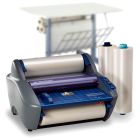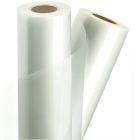Lamination and Laminators Troubleshooting Guide

Laminating is a combination of art and science. Here are some pointers to help you use your roll laminator to produce the highest quality laminations. MyBinding provides a wide selection of hot and cold laminators.
Making Heat Settings Modifications:
When first starting off, it is important to stick to the laminator's recommended heat settings. Nevertheless, depending on the film you're using and the materials you're laminating, those settings could need to be changed. Here are the fundamental principles and theories guiding the proper heat settings.
- When the laminate comes out of the laminator, it will be transparent but wavy if there is too much heat present. This is because there wasn't enough time for the film to cool in between two pairs of rollers. The laminator's temperature needs to be lowered as a fix. To give the laminator a chance to cool, you must wait before running more material.
- Your document will become silvery or cloudy if you don't have enough heat if the heat is applied unevenly. If this occurs, you will have to raise the heat's temperature in order to "wet out" the glue. After a lengthy laminating session, you might also need to give your laminator adequate time to regain heat because the rollers' temperature will decline as heat is transferred to your documents. The kind of printing techniques being used could be another factor contributing to silvering. For instance, the ink and toner used in inkjet and color copier output contain additives that call for specifically made films.
Secondly, ensure that you have the correct thermal laminating film for your hot laminator.
Making Speed Modifications:
Your laminating machine may be a single-speed or a variable-speed machine, depending on what it is. Only laminators with adjustable speed settings should be used, according to these remarks. The quantity of heat that is delivered onto the film can be directly influenced by changing the laminator's speed setting.
- When the laminate comes out of the laminator clear yet waved, this indicates that the film has absorbed too much heat. The film will spend less time on the heaters when the laminator's speed is increased, minimizing the amount of heat it absorbs.
- By slowing down, you extend the time the film spends on the heaters, which increases the amount of heat the film absorbs if your document has silvering or cloudiness.
This example demonstrates how temperature and speed work together harmoniously. Finally, to select the ideal setting for the kind of paper you are laminating, you must strike a balance between heat and speed.
Making Tension Adjustments:
How tightly the laminate is stretched when it exits the laminator depends on the tension setting. You want your movie to have as little stress as possible.
The goal is to impart just the right amount of tension to the film just before it hits the nip rollers, the first set of rollers, to smooth out any creases. If the wrinkle disappears before it reaches the nip where the two rolls of film come together, a small amount of wrinkling at the top of the roller or heat shoe is OK.
- Remove all the tension from the film mandrels before adding your film.
- After inserting the film into the device, gradually tighten the top and bottom rollers. If you don't do this evenly, the film will cup or bow as it comes off the rollers.
- The top or bottom rolls of film are stretched more than the opposite roll, which is what causes this. You might need to change your tension settings because when the film on the roll is utilized, the roll of the film will weigh less.
Just keep in mind that if you are running the same kind of film on both sides, the tension on both rollers should be always set at the same level.
Issues with De-Lamination:
De-lamination has grown to be a source of issues as the print industry transitions to digitally produced output. The biggest problem is with color copies or output from digital printing that contains a lot of fuser oil. If you are experiencing this issue, you might find that when your finished documents are face trimmed, the laminate will simply peel off. Consider utilizing a high-tack laminating film like Color-Bond if you are using this kind of digital output. To assure attachment to this coated output, this kind of film utilizes specialized adhesive chemistry.
In conclusion, the lamination process involves components of chemistry and physics. However, when you, as an operator, comprehend the science underlying lamination and can modify your equipment accordingly to produce the ideal output each time, then lamination becomes an art.









